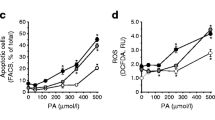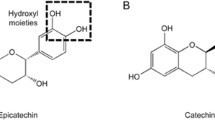Abstract
Omega-3 fatty acids have multiple effects in peripheral tissues and pancreatic beta cell function. Dietary depletion of omega-3 fatty acids is associated with pancreatic islet dysfunction and insulin resistance in rats. Herein, the effects of eicosapentaenoic acid (EPA) and docosahexaenoic acid (DHA) on pancreatic beta cell redox state and function were investigated. INS-1E insulin-secreting cells were incubated with EPA and DHA in combination with palmitic acid, and productions of reactive oxygen species (ROS), nitric oxide (NO) and insulin were measured. The involvement of the NADPH oxidase complex in ROS production and expression of the antioxidant enzymes was also investigated. After incubation for 1 or 48 h, productions of superoxide (by hydroethidine method), nitric oxide (by 4,5-diaminofluorescein diacetate-DAF-2DA assay), insulin (by radioimmunoassay), and expressions (by western blot analysis) of glutathione peroxidase (GPx-1) and gp91PHOX were measured. EPA and DHA reduced superoxide production after 1-h incubation. After 48 h, palmitic acid reduced superoxide production that was normalized by EPA treatment. Palmitic acid increased NO production that was reverted by EPA and DHA. Palmitic acid increased insulin secretion after 48 h, whereas both omega-3 fatty acids increased intracellular insulin content. EPA and DHA enhanced GPx-1 expression as well as gp91PHOX glycosylated form. In conclusion, EPA and DHA increased intracellular insulin content and antioxidant enzymatic defense capacity and decreased pro-oxidant generating activities that are associated with maintenance of pancreatic beta cell redox state in response to palmitic acid.






Similar content being viewed by others
References
Azevedo-Martins AK, Monteiro AP, Lima CL, Lenzen S, Curi R (2006) Fatty acid-induced toxicity and neutral lipid accumulation in insulin-producing RINm5F cells. Toxicol In Vitro 20:1106–1113
Burdge GC, Calder PC (2005) Conversion of alpha-linolenic acid to longer-chain polyunsaturated fatty acids in human adults. Reprod Nutr Dev 45:581–597
Carlsson C, Borg LA, Welsh N (1999) Sodium palmitate induces partial mitochondrial uncoupling and reactive oxygen species in rat pancreatic islets in vitro. Endocrinology 140:3422–3428
DeLeo FR, Burritt JB, Yu L, Jesaitis AJ, Dinauer MC, Nauseef WM (2000) Processing and maturation of flavocytochrome b558 include incorporation of heme as a prerequisite for heterodimer assembly. J Biol Chem 275:13986–13993
Diraison F, Parton L, Ferré P, Foufelle F, Briscoe CP, Leclerc I, Rutter GA (2004) Over-expression of sterol-regulatory-element-binding protein-1c (SREBP1c) in rat pancreatic islets induces lipogenesis and decreases glucose-stimulated insulin release: modulation by 5-aminoimidazole-4-carboxamide ribonucleoside (AICAR). Biochem J 378:769–778
Fedor D, Kelley DS (2009) Prevention of insulin resistance by n-3 polyunsaturated fatty acids. Curr Opin Clin Nutr Metab Care 12:138–146
Gehrmann W, Elsner M, Lenzen S (2010) Role of metabolically generated reactive oxygen species for lipotoxicity in pancreatic beta-cells. Diabetes Obes Metab 12(Suppl 2):149–158
Graciano MF, Santos LR, Curi R, Carpinelli AR (2011) NAD(P)H oxidase participates in the palmitate-induced superoxide production and insulin secretion by rat pancreatic islets. J Cell Physiol 226:1110–1117
Graciano MF, Valle MM, Curi R, Carpinelli AR (2013) Evidence for the involvement of GPR40 and NADPH oxidase in palmitic acid-induced superoxide production and insulin secretion. Islets 5:139–148
Graciano MF, Valle MM, Kowluru A, Curi R, Carpinelli AR (2011) Regulation of insulin secretion and reactive oxygen species production by free fatty acids in pancreatic islets. Islets 3:213–223
Grankvist K, Marklund SL, Taljedal IB (1981) CuZn-superoxide dismutase, Mn-superoxide dismutase, catalase and glutathione peroxidase in pancreatic islets and other tissues in the mouse. Biochem J 199:393–398
Griffiths MJ, Messent M, MacAllister RJ, Evans TW (1993) Aminoguanidine selectively inhibits inducible nitric oxide synthase. Br J Pharmacol 110:963–968
Harmon JS, Bogdani M, Parazzoli SD, Mak SS, Oseid EA, Berghmans M, Leboeuf RC, Robertson RP (2009) beta-Cell-specific overexpression of glutathione peroxidase preserves intranuclear MafA and reverses diabetes in db/db mice. Endocrinology 150:4855–4862
Hirabara SM, Silveira LR, Abdulkader F, Carvalho CR, Procopio J, Curi R (2007) Time-dependent effects of fatty acids on skeletal muscle metabolism. J Cell Physiol 210:7–15
Holness MJ, Greenwood GK, Smith ND, Sugden MC (2003) Diabetogenic impact of long-chain omega-3 fatty acids on pancreatic beta-cell function and the regulation of endogenous glucose production. Endocrinology 144:3958–3968
Itoh Y, Kawamata Y, Harada M, Kobayashi M, Fujii R, Fukusumi S, Ogi K, Hosoya M, Tanaka Y, Uejima H, Tanaka H, Maruyama M, Satoh R, Okubo S, Kizawa H, Komatsu H, Matsumura F, Noguchi Y, Shinohara T, Hinuma S, Fujisawa Y, Fujino M (2003) Free fatty acids regulate insulin secretion from pancreatic beta cells through GPR40. Nature 422:173–176
Kato T, Shimano H, Yamamoto T, Ishikawa M, Kumadaki S, Matsuzaka T, Nakagawa Y, Yahagi N, Nakakuki M, Hasty AH, Takeuchi Y, Kobayashi K, Takahashi A, Yatoh S, Suzuki H, Sone H, Yamada N (2008) Palmitate impairs and eicosapentaenoate restores insulin secretion through regulation of SREBP-1c in pancreatic islets. Diabetes 57:2382–2392
Kuriki K, Nagaya T, Tokudome Y, Imaeda N, Fujiwara N, Sato J, Goto C, Ikeda M, Maki S, Tajima K, Tokudome S (2003) Plasma concentrations of (n-3) highly unsaturated fatty acids are good biomarkers of relative dietary fatty acid intakes: a cross-sectional study. J Nutr 133:3643–3650
Lenzen S (2008) Oxidative stress: the vulnerable beta-cell. Biochem Soc Trans 36:343–347
Li N, Frigerio F, Maechler P (2008) The sensitivity of pancreatic beta-cells to mitochondrial injuries triggered by lipotoxicity and oxidative stress. Biochem Soc Trans 36:930–934
Liu X, Xue Y, Liu C, Lou Q, Wang J, Yanagita T, Xue C, Wang Y (2013) Eicosapentaenoic acid-enriched phospholipid ameliorates insulin resistance and lipid metabolism in diet-induced-obese mice. Lipids Health Dis 12:109
Lucena CF, Roma LP, Graciano MF, Veras K, Simões D, Curi R, Carpinelli AR (2015) Omega-3 supplementation improves pancreatic islet redox status: in vivo and in vitro studies. Pancreas 44:287–295
Martens GA, Cai Y, Hinke S, Stange G, Van de Casteele M, Pipeleers D (2005) Glucose suppresses superoxide generation in metabolically responsive pancreatic beta cells. J Biol Chem 280:20389–20396
Meidute Abaraviciene S, Lundquist I, Galvanovskis J, Flodgren E, Olde B, Salehi A (2008) Palmitate-induced beta-cell dysfunction is associated with excessive NO production and is reversed by thiazolidinedione-mediated inhibition of GPR40 transduction mechanisms. PLoS One 3:e2182
Michalska M, Wolf G, Walther R, Newsholme P (2010) Effects of pharmacological inhibition of NADPH oxidase or iNOS on pro-inflammatory cytokine, palmitic acid or H2O2-induced mouse islet or clonal pancreatic beta-cell dysfunction. Biosci Rep 30:445–453
Moran BM, Abdel-Wahab YH, Flatt PR, McKillop AM (2014) Evaluation of the insulin-releasing and glucose-lowering effects of GPR120 activation in pancreatic β-cells. Diabetes Obes Metab 16:1128–1139
Mori Y, Murakawa Y, Yokoyama J, Tajima N, Ikeda Y, Nobukata H, Ishikawa T, Shibutani Y (1999) Effect of highly purified eicosapentaenoic acid ethyl ester on insulin resistance and hypertension in Dahl salt-sensitive rats. Metabolism 48:1089–1095
Moriscot C, Richard MJ, Favrot MC, Benhamou PY (2003) Protection of insulin-secreting INS-1 cells against oxidative stress through adenoviral-mediated glutathione peroxidase overexpression. Diabetes Metab 29:145–151
Oguzhan B, Zhang Y, Louchami K, Courtois P, Portois L, Chardigny JM, Malaisse WJ, Carpentier YA, Sener A (2006) Pancreatic islet function in omega3 fatty acid-depleted rats: glucose metabolism and nutrient-stimulated insulin release. Endocrine 29:457–466
Oliveira HR, Curi R, Carpinelli AR (1999) Glucose induces an acute increase of superoxide dismutase activity in incubated rat pancreatic islets. Am J Physiol 276:C507–510
Paclet MH, Coleman AW, Burritt J, Morel F, NADPH oxidase of Epstein-Barr-virus immortalized B lymphocytes (2001) Effect of cytochrome b(558) glycosylation. Eur J Biochem 268:5197–5208
Pinel A, Morio-Liondore B, Capel F (2014) n-3 Polyunsaturated fatty acids modulate metabolism of insulin-sensitive tissues: implication for the prevention of type 2 diabetes. J Physiol Biochem 70:647–658
Rebelato E, Abdulkader F, Curi R, Carpinelli AR (2011) Control of the intracellular redox state by glucose participates in the insulin secretion mechanism. PLoS One 6:e24507
Richieri GV, Kleinfeld AM (1995) Unbound free fatty acid levels in human serum. J Lipid Res 36:229–240
Schraer CD, Lanier AP, Boyko EJ, Gohdes D, Murphy NJ (1988) Prevalence of diabetes mellitus in Alaskan Eskimos, Indians, and Aleuts. Diabetes Care 11:693–700
Shao S, Liu Z, Yang Y, Zhang M, Yu X (2010) SREBP-1c, Pdx-1, and GLP-1R involved in palmitate-EPA regulated glucose-stimulated insulin secretion in INS-1 cells. J Cell Biochem 111:634–642
Spector AA, Fletcher JE, Ashbrook JD (1971) Analysis of long-chain free fatty acid binding to bovine serum albumin by determination of stepwise equilibrium constants. Biochemistry 10:3229–3232
Syed I, Kyathanahalli CN, Jayaram B, Govind S, Rhodes CJ, Kowluru RA, Kowluru A (2011) Increased phagocyte-like NADPH oxidase and ROS generation in type 2 diabetic ZDF rat and human islets: role of Rac1-JNK1/2 signaling pathway in mitochondrial dysregulation in the diabetic islet. Diabetes 60:2843–2852
Vemuri M, Kelley DS, Mackey BE, Rasooly R, Bartolini G (2007) Docosahexaenoic acid (DHA) but not eicosapentaenoic acid (EPA) prevents trans-10, cis-12 conjugated linoleic acid (CLA)-induced insulin resistance in mice. Metab Syndr Relat Disord 5:315–322
Wang X, Vatamaniuk MZ, Roneker CA, Pepper MP, Hu LG, Simmons RA, Lei XG (2011) Knockouts of SOD1 and GPX1 exert different impacts on murine islet function and pancreatic integrity. Antioxid Redox Signal 14:391–401
Wang XD, Vatamaniuk MZ, Wang SK, Roneker CA, Simmons RA, Lei XG (2008) Molecular mechanisms for hyperinsulinaemia induced by overproduction of selenium-dependent glutathione peroxidase-1 in mice. Diabetologia 51:1515–1524
Wei D, Li J, Shen M, Jia W, Chen N, Chen T, Su D, Tian H, Zheng S, Dai Y, Zhao A (2010) Cellular production of n-3 PUFAs and reduction of n-6-to-n-3 ratios in the pancreatic beta-cells and islets enhance insulin secretion and confer protection against cytokine-induced cell death. Diabetes 59:471–478
Welsh N, Eizirik DL, Bendtzen K, Sandler S (1991) Interleukin-1 beta-induced nitric oxide production in isolated rat pancreatic islets requires gene transcription and may lead to inhibition of the Krebs cycle enzyme aconitase. Endocrinology 129:3167–3173
Zhang Y, Bulur N, Peltier S, Carpentier YA, Malaisse WJ, Sener A (2008) Long-chain fatty acyl-coenzyme A-induced inhibition of glucokinase in pancreatic islets from rats depleted in long-chain polyunsaturated omega3 fatty acids. Cell Biochem Funct 26:233–237
Zhang Y, Crutzen R, Louchami K, Carpentier YA, Sener A, Malaisse WJ (2009) Direct effects of eicosapentaenoic and docosahexaenoic acids on phospholipid and triglyceride fatty acid pattern, glucose metabolism, 86rubidium net uptake and insulin release in BRIN-BD11 cells. Endocrine 35:438–448
Zhang Y, Oguzhan B, Louchami K, Chardigny JM, Portois L, Carpentier YA, Malaisse WJ, Herchuelz A, Sener A (2006) Pancreatic islet function in omega-3 fatty acid-depleted rats: alteration of calcium fluxes and calcium-dependent insulin release. Am J Physiol Endocrinol Metab 291:E441–448
Acknowledgments
The authors are grateful to Marlene Santos Rocha and Dr. Patrícia Riva Patrício for excellent technical assistance. This study has been supported by Fundação de Amparo à Pesquisa do Estado de São Paulo (FAPESP), Conselho Nacional de Desenvolvimento Cientifico e Tecnológico (CNPq), the Instituto Nacional de Obesidade e Diabetes (INCT), and the US Department of Veterans Affairs.
Author information
Authors and Affiliations
Corresponding author
Ethics declarations
Conflict of interest
The authors declare no conflict of interest.
Rights and permissions
About this article
Cite this article
Graciano, M.F., Leonelli, M., Curi, R. et al. Omega-3 fatty acids control productions of superoxide and nitrogen oxide and insulin content in INS-1E cells. J Physiol Biochem 72, 699–710 (2016). https://doi.org/10.1007/s13105-016-0509-1
Received:
Accepted:
Published:
Issue Date:
DOI: https://doi.org/10.1007/s13105-016-0509-1




